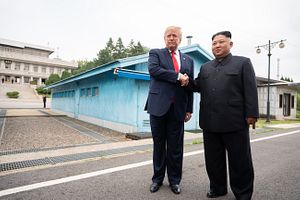U.S. President Donald Trump’s summit diplomacy with North Korean leader Kim Jong-un is back on. The two leaders met on the last day of June for a quick meeting at the inter-Korean Joint Security Area, along the Military Demarcation Line that has separated North and South Korea since 1953.
The meeting served an important purpose: it allowed both leaders to replace the bitter aftertaste of their last summit encounter in Hanoi, Vietnam, in February with something sweeter. In practical terms, Trump and Kim agreed to re-establish working-level talks between lower-level functionaries from both countries.
The summit has caused a surge of optimism worldwide, with many newspaper headlines expressing optimism that “stalled” nuclear negotiations will be back on. But, as should be clear by now, no amount of Trump-Kim pageantry will save this process until the underlying fundamentals improve.
It was these troublesome and mismatched fundamentals – expressed in each sides’ negotiating position – that caused the collapse of the summit in Hanoi. In short, North Korea is not ready to give up its nuclear weapons and the United States is not ready to offer Pyongyang sanctions relief for anything short of total disarmament.
This basic reality existed leading up to the first U.S.-North Korea summit in June 2018, when Trump and Kim had their historic meeting in Singapore. Now, even as Trump became the first sitting U.S. president to symbolically step foot on North Korean soil, these fundamentals have yet to change.
Working-level talks between the two sides, if they resume as planned, will look familiar. Stephen Biegun, the American special representative on North Korea, lamented that his previous counterparts appeared not to be empowered to discuss nuclear disarmament issues with any degree of specificity. That is unlikely to change.
In fact, what Biegun is likely to hear from his North Korean counterpart will be a familiar message – one that Kim Jong-un delivered publicly during his 2019 New Year’s Day address. Addressing the then-stalled diplomacy between the two countries, Kim outlined his view that North Korea had already taken steps to symbolically “freeze” many of its provocative activities and now it was, in effect, the United States’ turn to offer up “corresponding” steps – in the form of sanctions relief.
If U.S. negotiators are hoping to get something for nothing from North Korea, they will be sorely disappointed. The North Koreans view their self-imposed moratorium on testing intercontinental-range ballistic missiles and the dismantlement of their main nuclear testing site as deeds that have gone unrewarded to date.
Even as the latest summit has infused the process with another injection of optimism, Kim’s warning in April, in his first public remarks after the failure in Hanoi, should remain at the top of our minds. Speaking to the Supreme People’s Assembly, North Korea’s analog to a parliament, Kim warned that the United States had until the end of the year to fundamentally revise its position on sanctions relief.
After three summits, it’s clearer than ever that the Trump-Kim channel in U.S.-North Korea relations is doing little to shift the needle on policy. In Washington especially, hardliners like Secretary of State Mike Pompeo and National Security Adviser John Bolton continue to resist any review of the administration’s North Korea policy, which remains committed to the “maximum pressure” formula that was identified back in April 2017.
Sure, Trump and Kim have helped the world forget the disappointing outcome of their talks in Hanoi with a historic show at the inter-Korean border, but it’s best not to lose sight of the broader context of their meeting. For true progress in the relationship, American negotiators will have to reassess their fundamental approach.
This article first appeared in the South China Morning Post. It is republished here with kind permission.
































